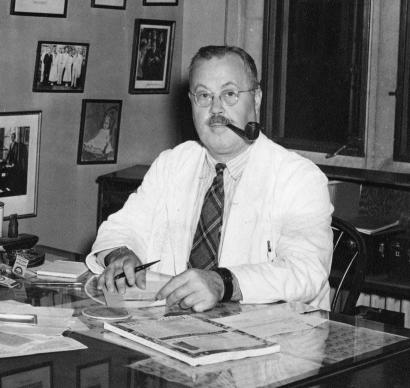
Poison Epidemic
Part I: A young Duke resident is alarmed by the amount of seemingly preventable cases of poisoning in children.

The Setting: Duke Department of Pediatrics
The Duke University Hospital and the Duke University School of Medicine opened in 1930. The Department of Pediatrics was one of the original 10 departments. It was chaired by Dr. Wilburt C. Davison who also served as Dean of the School of Medicine from 1930-1960.
Father of Poison Control: Dr. Jay Arena
Dr. Jay Arena came to Duke in 1930 as a medical student in the first class at Duke's School of Medicine. After residency and a short stint at Vanderbilt University as an instructor in pediatrics, he returned to Duke's Medical School as a professor of pediatrics.
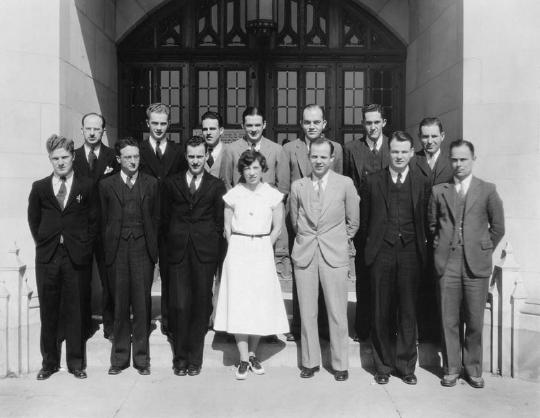 Senior medical students, 1932. Dr. Arena is on the first row, far left
Senior medical students, 1932. Dr. Arena is on the first row, far left
An Alarming Trend in Duke Pediatric Cases
Between 1930 and 1950, there were 285 pediatric cases of lye poisonings at Duke Hospital. These children were suffering from severe esophageal burns. Though parents were using lye effectively as a cleansing agent, its presence in the home was a danger. The high incidence of young patients who had swallowed lye (thinking it looked like milk when it was in solution) was an alarming trend which continued for decades in North Carolina.
“Lye, which will ‘eat the stains from the boiling kettle,’ will have a much direr effect on the oral or esophageal mucosa.” – Kernodle, Taylor, Davison, 1948 article in American Journal of Diseases in Children.
Early Advocacy Efforts from Dr. Jay Arena
As Dr. Arena's career at Duke grew, he became an outspoken advocate for legally banning the sale of lye for home use. He worked with public servants, such as Watts Hill, Jr., to introduce “the lye bill” to the North Carolina legislature. It was Dr. Arena's concern for lye patients that began his lifelong interest in poison control.
Duke Pediatricians Lobby Legislators to Pass 'the Lye Bill'
In 1957, Dr. Arena and Duke colleagues Dr. Susan Dees and Dr. Jerome Harris expressed their support of the “lye bill,” or HB No. 867, “A Bill to be Entitled an Act to Regulate the Sale of Sodium Hydroxide, or Concentrated Lye.”
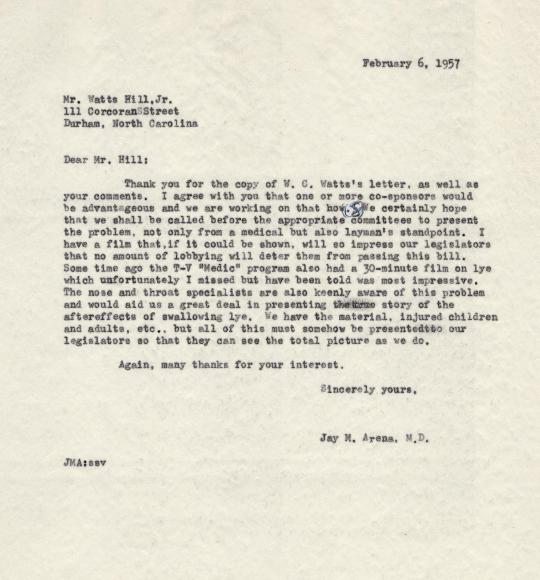
February 6, 1957
Mr. Watts Hill, Jr.
111 Corcoran Street
Durham, North Carolina
Dear Mr. Hill:
Thank you for the copy of W.C. Watts's letter, as well as your comments. I agree with you that one or more co-sponsers would be advantageous and we are working on that now. We certainly hope that we shall be called before the appropriate committees to present the problem, not only from a medical but also layman's standpoint. I have a film that, if it could be shown, will so impress our legislators that no amount of lobbying will deter them from passing this bill. Some time ago the T-V “Medic” program also had a 30-minute film on lye which unfortunately I missed but have been told was most impressive. The nose and throat specialists are also keenly aware of this problem and would aid us a great deal in presenting the story of the after effects of swallowing lye. We have the material, injured children and adults, etc., but all of this must somehow be presented to our legislators so that they can see the total picture as we do.
Again, many thanks for your interest.
Sincerely yours,
Jay M. Arena, M.D.
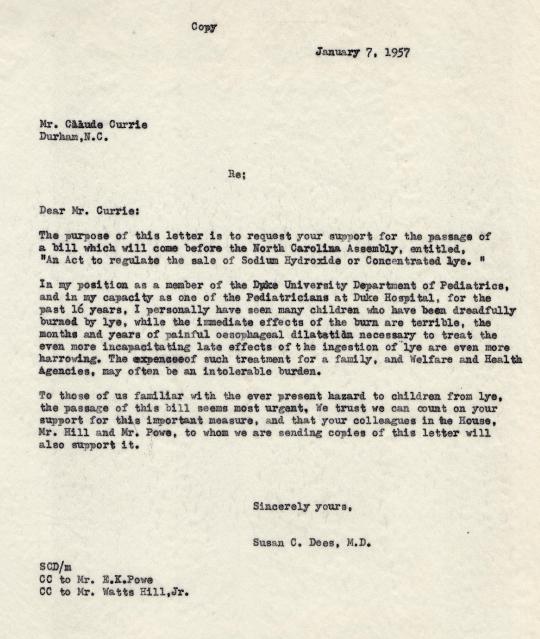
January 7, 1957
Mr. Caaude Currie
Durham, N.C.
Re;
Dear Mr. Currie:
The purpose of this letter is to request your support for the passage of a bill which will come before the North Carolina Assembly, entitled, “An Act to regulate the sale of Sodium Hydroxide or Concentrated Lye.”
In my position as a member of the Duke University Department of Pediatrics, and in my capacity as one of the Pediatricians at Duke Hospital, for the past 16 years, I personally have seen many children who have been dreadfully burned by lye, while the immediate effects of the burn are terrible, the months and years of painful oesophageal dilatation necessary to treat the even more incapacitating late effects of the ingestion of lye are even more harrowing. The expenses of such treatment for a family, and Welfare and Health Agencies, may often be an intolerable burden.
To those of us familiar with the ever present hazard to children from lye, the passage of this bill seems most urgent. We trust we can count on your support for this important measure, and that your colleagues in the House, Mr. Hill and Mr. Powe, to whom we are sending copies of this letter also support it.
Sincerely yours,
Susan C. Dees, M.D.

January 4, 1957
The Honorable E.K. Powe
North Carolina House of Representatives
Raleigh, N.C.
Dear Representative Powe,
I am writing to endorse the bill to regulate the sale of concentrated lye and to urge its passage in the North Carolina Legislature. We who see the terrible effects of the accidental swallowing of this material by children are unanimous in doing whatever we can to prevent such unnecessary suffering. These children almost always show a severe immediate reaction to the accidental ingestion, -having severe and painful burns of the face, mouth and throat. They cannot swallow for a considerable period of time. This is bad enough but is not the most serious difficulty wich results. Later on, after a period of weeks or months, there is a gradual closure of the esophagus so that the child can no longer swallow his food. An extremely prolonged and costly program involving many hospitalizations is then necessary in order to either open the esophagus or bypass the narrowed areas surgically. The cost of such care runs into the thousands of dollars for each individual, -monies that could be very profitably used for children with other illnesses if lye poisoning could be prevented.
For these reasons, I cannot too strongly urge the passage of this bill. Thank you very much for your cooperation.
Sincerly yours,
Jerome S. Harris, M.D.
Chairman, Department of Pediatrics
When the bill did not pass in 1957, Dr. Arena continued to work with concerned activists on a bill to present at an upcoming session of the House.
Index Cards: the Key to Early Documentation of Poison Cases
Early in his career, Dr. Arena began recording cases of accidental poisonings and the ingredients that caused them.
As his reputation grew, physicians increasingly called him with questions they had about poison cases. His careful documentation of each case provided a great reference guide for these consultations.
Pediatric Residents Enlisted to Help
Each year, Dr. Arena selected one resident in the Duke Department of Pediatrics to work with him. This resident would help him organize index cards documenting cases of poisonings and their causes, as well as information about consumer products and their potential toxicity. With each phone call being documented on index cards, the body of collected information quickly grew.
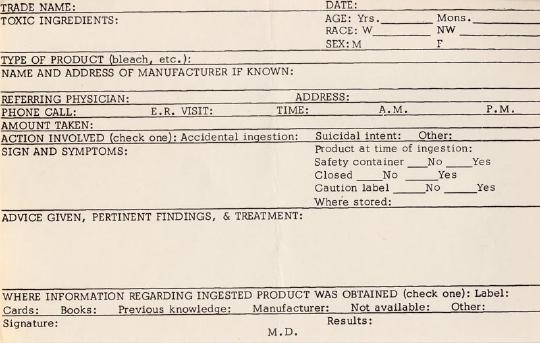
1-1-4 Poison Control
As Duke received more and more phone calls to access its growing body of information, Dr. Arena and Dr. Harris developed a system available 24 hours a day to speak with a resident about poison-related problems.
When calls came in to the hospital's main line, the operator would take the call and signal the paging operator, who would announce “1-1-4, Poison Control, indicating for the resident on call to pick up the phone. By answering the caller's question directly, the resident would be able to instruct the caller in how to handle the problem by referring to the index cards on file. Eventually, beepers and computers would simplify this system.

